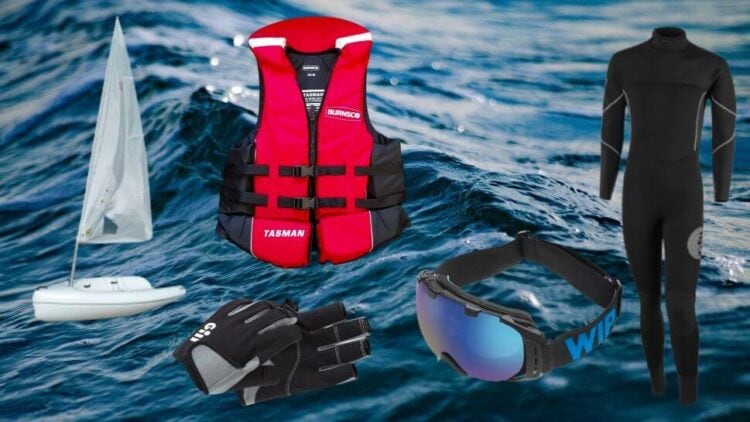
OBJECTIVE OF SAILING: Cross the finish line before all other boats.
NUMBER OF PLAYERS: 2+ players
MATERIALS: Boat, life jacket/floatation device, goggles, wetsuit, gloves
TYPE OF GAME: Sport
AUDIENCE: 10+
OVERVIEW OF SAILING
Sailing is a popular water sport that sees competitors maneuver their wind-powered boats around a designated course. While sailing is most commonly a relaxing, recreational activity, it is also a very competitive sport, having been featured in the Summer Olympic Games since 1896!
The origins of sailing must be traced back thousands of years to when humans first began constructing boats for world sailing travel. This time period is thought to have been around 7,000 BCE, with evidence of ancient sailing originating in the Mediterranean and Middle Eastern regions.
Modern sailing is thought to be largely influenced by the Dutch, specifically with their creation of the yacht in the 1300s. At this time, the yacht was a small, speedy sailboat used to catch pirates and other criminals at sea. Due to the immense success of this maritime policing, wealthy merchants began taking pleasure cruises in their yachts to celebrate.
Nowadays, boats of all kinds are used for sailing races, although most races are confined to wind-based boats only, such as the widely popular “laser” dinghy. With that said, modern engine-based yachts can still take part in many races today, but these races are generally far more recreational than competitive. Most competitive races have a race committee who define the racing rules of sailing for its competitors, though the fundamental principle of sailing instructions stay the same.
SETUP

EQUIPMENT
- Boat: The specifications of each boat in a race are dependent on the type of race taking place. While there aren’t always strict rules for a boat’s dimensions and weight, organizers usually implement a weight limit for the extra equipment on the boat. Refer to the BOATS section below for more information.
- Life Jacket: A life jacket or similar body-worn floatation device is necessary in case of emergency.
- Wetsuit: Similar to the life jacket, wetsuits are highly recommended in case a sailor goes overboard.
- Gloves: Durable gloves are necessary to avoid rope burns caused by tugging on the sails.
- Goggles: Sailors should wear goggles to protect their visibility from splashing water caused by rough waters.
BOATS
At the Olympic level, there are eight different sailing events, each featuring a unique wind-powered vessel that is categorized into four separate classifications:
- Dinghy – These are small boats with a mast and sails. Historically, these boats were used to shuttle passengers to and from larger vessels. The boats (and events) that fit this boat classification include:
- Laser: An extremely simple boat with a common hull design; designed for a single sailor.
- Laser Radial: Features a smaller sail and shorter mast than the normal laser; designed for a single sailor.
- Finn: A heavyweight, one-person vessel.
- 470: A very similar design to the laser, albeit with a sail even smaller than a laser radial; a two-person crew commonly sails this boat.
- Windsurf – These boats feature a completely flat hull and a mast with sails. Essentially, these are surfboards with sails. Uniquely, these boats rely on the waves as much as they do the wind.
- RS:X: The only windsurf model used in the Olympics; designed for a one-person crew.
- Skiff – These boats are part of a generally unrelated classification of vessels, with “skiff” usually referring to a “normal” ship. The two skiff boats used in Olympic races feature two-person, double-trapeze crews who tether on the edge of the boat while attached to the sail by a harness.
- 49er: This boat is named because of its 4.99-meter hull length.
- 49erFX: A variant of the traditional 49er that features a slightly smaller mast and sail.
- Multihull – These boats have a very distinct look due to the fact they contain two separate hulls, with a mast and sails sitting between the two hulls. This design allows these boats to have great stability and buoyancy.
- Nacra 17: A multihull boat designed for a two-person, double-trapeze crew.
RACE TYPES
Most sailing competitions feature one of two different race types:
- Match Racing: This style of event pits one boat up against another boat in a race to the finish line.
- Fleet Racing: The more common style of race, fleet racing involves a large number of boats that all race each other. In the event that competitors are not all competing in identical boats, “handicaps” can be given to slower boats, such as head starts or time taken off of their final time.
GAMEPLAY

A sailing race has a long start process with many race signals, as the boats cannot perfectly line up at a starting line to the waves and wind. Because of this, a sound signal is repeated multiple times before the race starts, including a warning signal at six minutes, five minutes, and one minute.
Once the one-minute horn goes off, competitors should position themselves in a manner that will allow them to cross the start line as soon as possible once the starting horn sounds.
Once the race starts, competitors race toward the first “mark”, which is a large buoy that competitors must race around. Upon reaching a mark, all sailors must go around the buoy in a predetermined direction before heading toward the next mark. After rounding the last mark, sailors must race through a finish line that is located between two large boats.
SCORING
Competitors in fleet racing are given a score correlated with which place they finish the race. For example, in a 15-boat race, the first boat to cross the line is awarded one point, while the last boat to complete the race scores 15.
Since most sailing events feature multiple rounds of races, these scores are added together after each race and help decide the final rankings.
RULES
There are two main rules sailors must abide by during races:
- False Starts: Successfully timing a starting horn can be a huge advantage in sailing. More careful sailors will generally hang back behind the starting line to avoid the wind or waves accidentally pushing them past it. Crossing the start line too quickly (and thus getting a false start) will result in the offender(s) having to turn around and return to their start position before they can continue their run, while all other competitors are unimpeded. If officials cannot determine which boat(s) committed this infraction, all boats must restart the race. The black flag rule also states that in the last minute when a black flag is raised no boat should cross the starting line or they will be disqualified or the race restarted.
- Right of Way: When approaching marks, boats can come into close contact with each other. In these instances, sailors must know who has the right of way. In general, the portside boat (left side) should never impede the broadside (right side) boat. Likewise, the windward boat (closest to the wind) must always yield to the leeward boat (farthest from the wind).
HOW BOATS SAIL INTO THE WIND
As the location of marks forces boats to change direction, it is almost inevitable that sailors will eventually have to sail into the wind. Avoiding sailing into the wind is nearly impossible. This is where the technique known as “tacking” comes into play.
Tacking is essentially a zig-zag motion that allows a boat to avoid sailing directly into the wind while still progressing toward a destination that is directly upwind. For example, to sail north against a wind moving directly south, a sailor will sail northeast, then northwest, then northeast again, northwest again, and so on.
When watching a sailing race, tacking is often the reason why boats sail in seemingly opposite directions and end up far distances apart before their paths eventually meet again at the target mark. When boats are on the same tack, however, the boat ahead must mark room and allow the other boat room to maneuver.
END OF GAME
Similar to golf, the sailor(s) with the lowest total score after all racing events have been completed is the winner. If multiple boats are tied, the tiebreaker goes to whichever boat finished in a better spot in the final (medal) race.
- 30 GAMES TO PLAY OVER TEXT - April 22, 2024
- 20+ FREE PRINTABLE BABY SHOWER GAMES - April 16, 2024
- 20+ College Party Games for the Best Night Ever! - April 2, 2024